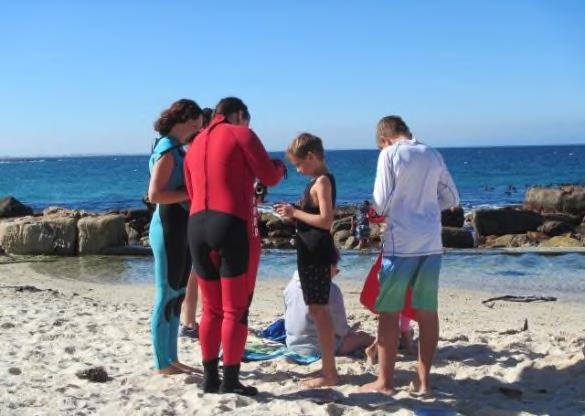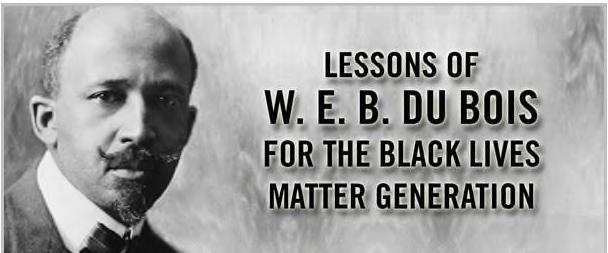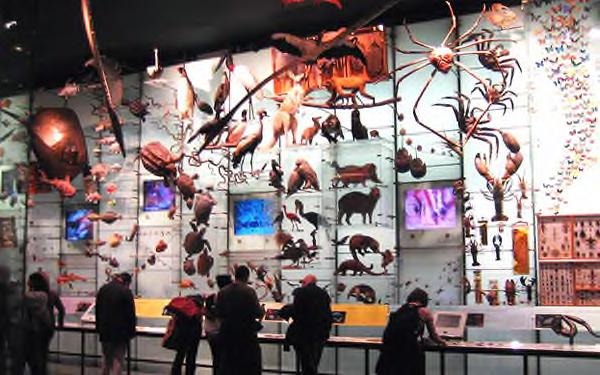
12 minute read
Interpreting Climate Change at History Based Parks. Elizabeth A. Villano
InterpNews
Interpreting Climate Change at History Based Parks
Advertisement

Elizabeth A. Villano National Park Service elizabeth_villano@nps.gov
If someone tried to tell the story of your life, would you trust them to capture your essence? Can someone else provide the textured fabric of context behind your every good and bad decision, every missed or fulfilled opportunity? A person’s lifetime is a mosaic of complex and nuanced stories, fragments that are easier to explain apart than together. Now multiply that challenge by 133 million people1, the number of Americans alive in 1941 when the US officially entered WWII. Designated a National Park Service site in 2000, Rosie the Riveter WWII Home Front National Historical Park (NHP) strives to encompass the entire story of the WWII Home Front in the United States. We blend individual stories with the larger tapestry of the national experience- doing our best to encompass how much an individual’s Home Front experience could vary based on race, gender, ideology, or even physical location.
One of the park’s main themes is mass mobilization. During WWII, the entire country transformed at an individual level, community level, business level, and governmental level. People gave up certain liberties, enduring shortages and dealing with rations placed on gasoline, food, and clothing. 2 Businesses transformed to meet wartime production needs- the year after Pearl Harbor was bombed American Radiator and Standard Company transformed from producing “bathtubs to bombs”.3 And the federal government took unprecedented control over the economy, appropriating money to defense industries and choreographing the immense transformation to a nation at war.
This story ignited my curiosity as a Park Ranger. When people visit our park site, what current day events do they uphold as being worthy for the next mass mobilization? Is there a ‘greater good’ similar to the way the US mobilized around the threat of fascism during WWII? I put that question on a whiteboard, and invited park visitors to answer. In the few months it has been up, hundreds of people have voiced the issue they would like to see addressed on sticky notes. Sometimes these sticky notes would be in direct contrast with each other, and other times several sticky notes would build on each other with vibrant ‘agrees!’ or ‘seconded!’.
As topics cycled throughout the board, as if in a waltz with the mainstream news cycle, the issue of climate change is always the winner. A majority of people coming to their National Parks want our country to mobilize once again in scale and scope to ensure a livable future for us and future generations.
InterpNews
Similar to the story of the WWII Home Front, climate change is not a single, easy digested topic. The story of climate change encompasses a whole range of associated issues- the mass movement of people, income inequality, housing insecurity, the disproportionate effects on vulnerable populations and people of color, and more. As shown by the board, when people come to our park site, they often make that association unprompted. As interpreters moving towards 21st century interpretation, our responsibility is to take this feedback from the public seriously and find a way to incorporate it into our programming. Especially when the issue at hand is one that the former director of the National Park Service Jonathan Jarvis called “the single greatest threat to the integrity of the parks that has ever been experienced”.4
Climate change is affecting National Parks faster than it affects other parts of the country 5. Larger wilderness-based parks are faced with projections that threaten the namesake of the park they represent, such as Glacier National Park potentially losing all of its glaciers by the midcentury. 6 Comparatively, it may not seem as though Rosie the Riveter/WWII Home Front NHP, with a visitor center in a two-story brick building holding a collective societal memory, would be facing the threats of climate change in the same immediate sense. However, our scenic location on the San Francisco Bay gives us many opportunities to talk about the impacts of climate change. For example, every winter our historical building floods with saltwater during high tide events and storm surges, an event that will only get more frequent as the sea level continues to rise. The Bay also serves as a dynamic resource to discuss and investigate how industry might affect food webs and ocean acidification.
Historical parks can also be used as a tool to step back and view our nation's history from a broader perspective; a chance to investigate the environmental impacts of progress and technology. The World War II Home Front was a time of immense innovation and rapid industry conversion, everyone mobilizing to protect the fabric of American identity and society. However, environmental legacies from the Home Front are still impacting us today. In Richmond California, the community where the park resides, there are still Brownfields - sites left over from ship building for the war, highly contaminated sites where the toxins left over from industry complicate people’s ability to safely live.7
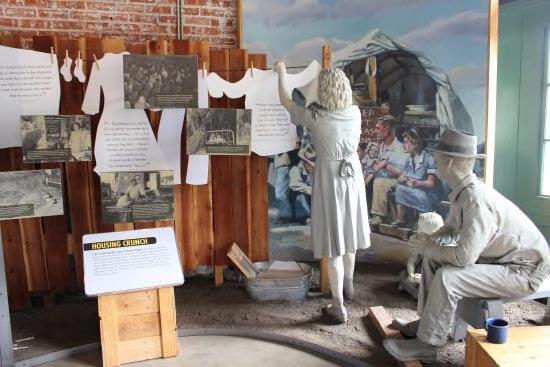
InterpNews
In the 1940s, little was known about the impacts of burning fossil fuels, and the effect it has on the environment. Today we know that burning fossil fuels, like coal oil and natural gas, releases carbon dioxide (CO2) into the Earth’s atmosphere. CO2 acts like a heat trapping blanket and is a natural phenomenon. But it gets thicker and thicker as our factories and cars release more and more CO2 into the air, disturbing the Earth’s atmosphere and normal climate patterns. This is a major cause of human-caused climate change, the issue that shows up time and again when people use are asked what our most pressing current issue is. The historical park here offers visitors a chance to see how the history not only shapes the future, but also how we can use the past to inform our future. Much as the people of the WWII Home Front mobilized, sacrificed, and innovated to combat a shared common enemy, today we can do the same to mitigate the shared effect of climate change.
From today’s vantage point, we can investigate the burning of fossil fuels and the environmental impacts of wartime mobilization without the paralysis of fear and need of wartime supplies masking our thoughts. Historical parks like Rosie the Riveter/WWII Home Front NHP can be used as a chance to investigate the question of safety: how do we grapple with the mixed legacy of progress and national security?
The challenge of interpreting climate change in a historical park is that it sometimes doesn’t appear to directly tie into the resource. However, historical parks, no matter the time, era, or culture, have connections to climate change stories. A site could investigate the impacts of climate change on its resource or investigate the environmental legacies of the culture that reigned during the period of significance for that site. That same site could utilize the cultural movements and foundations as a blueprint to see how our society could react to a rapidly changing climate and the diverse range of social issues that come with it. The more sites that talk about climate change in a historical setting, the more likely we are to be able to mobilize all aspects of society to face this pressing issue.
1- “US Population From 1900”. Demographia. Wendell Cox Consultancy, 2001. Web. Accessed 11/9/19. <http://demographia.com/db-uspop1900.htm>
2- Sears, Stephen W (1979). Sorry No Gas: How Americans Met the First Great Gasoline Crisis- Nearly Forty Years Ago. American Heritage Journal, 30 (6). Retrieved from: https://www.americanheritage.com/sorry-no-gas
3- Graves, Donna. “Mapping Richmond’s World War II Home Front”. Historical Report prepared for the National Park Service, 2004. Accessed at <https://www.academia.edu/9142774/MAPPING_RICHMONDS_WORLD_WAR_II_HOME_FRONT>
4- Shockman, Elizabeth. “Climate Change is a Huge Threat to our National Parks”. PRI, Public Radio International, 6/19/16. Web. Accessed 11/9/19. < https://www.pri.org/stories/2016-06-19/climate-change-huge-threat-our-national-parks>
5- Gonzalez, Patrick. “Human-Caused Climate Change in the United States National Parks”. Testimony to the United States House of Representatives, 2/13/19. Web. Accessed 11/9/19 <https://naturalresources.house.gov/imo/media/doc/Gonzalez,%20Patrick%20%20Written%20Testimony%202019-02-13.pdf>
6- Pariona, Ameber. “The Glaciers of Glacier National Park: Will They Disappear by 2030?” WorldAtlas, 6/18/18. Web. Accessed 11/9/19. <https://www.worldatlas.com/articles/the-glaciers-of-glacier-national-park-will-they-disappear-by-2030.html>
7- “Brownfields: HAZMAT Cleanup, but more”, National Institute of Environmental Health Sciences, April 1998. Web. Accessed 11/24/19 <https://tools.niehs.nih.gov/wetp/public/hasl_get_blob.cfm?ID=1353>
InterpNews
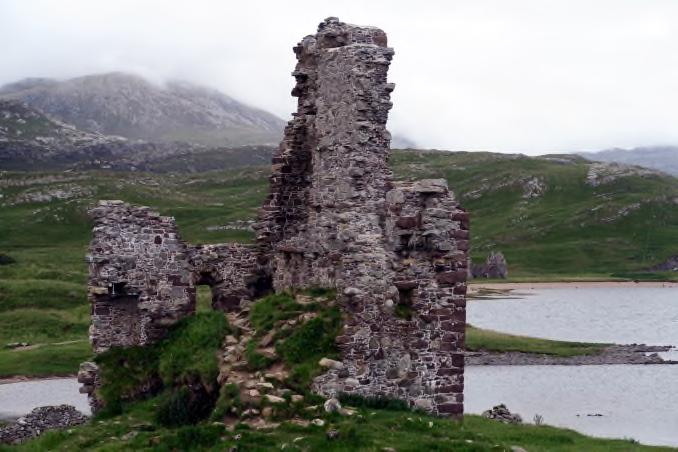
Weeping ghost of Ardvreck Castle, Loch Assynt, once betrothed to the Devil
Douglas MacQueen
There is an air of mystery about Loch Assynt (Scottish Gaelic: Loch Asaint) in Sutherland, Scotland. A freshwater loch, it lies in a spectacularly beautiful setting surrounded by the mountains in the area of Assynt. Noted for its wonderful landscape its has, along with neighbouring Coigach, been designated as the AssyntCoigach National Scenic Area (NSA). NSA's are areas in Scotland identified for their exceptional scenery with a conservation designation that protects them from inappropriate development. Loch Assynt is beautiful and takes its mood from the many changes in weather conditions that take place in this part of Scotland. Sometimes the water is still, calm and like a mirror, reflecting the magnificent surrounding snow capped mountains. At times the waters are whipped up by the winds that sweep down the hillsides. At its most mysterious it is shrouded by a mist that swirls over the flat surface of the Loch. Where every sound; some that can be identified and others that can't, echo around the water's edge. It is the type of setting that is ripe for stimulating the imagination.
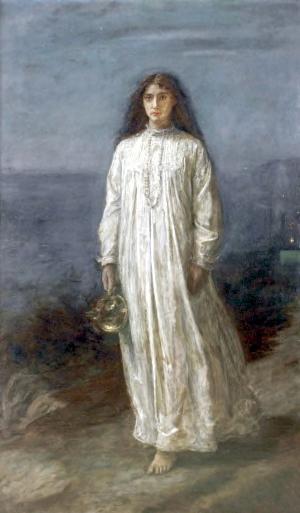
Scotland, like other Celtic nations, abounds in myths, folklore and legend stretching far back into prehistory, many of which are tied to specific locations be they forests, lochs, glens, mountains, ancient burial chambers, cairns or darkened corners of old towns and cities. Often fuelled by actual historic events involving dark deeds, Scotland’s battlegrounds, old houses and castles are also noted for stories of the supernatural and ghostly activity.
Castles that stand in remote landscapes can be particularly suggestive of this type of paranormal phenomena. Ardvreck Castle is one such place. The ruins of Ardvreck Castle stand on a rocky promontory at the edge of Loch Assynt. Built towards the end of the 15th century it was the seat of the MacLeods of Assynt (Scottish Gaelic: Asainte). Originally a three or four storey rectangular building it was later extended and the accommodation improved with the addition of a tower. Like many Scottish castles Ardvreck has a dark and troublesome history. It has been the site of sieges, murders and executions involving inter-MacLeod fighting as well as battles with traditional enemies. It was the place where James Graham, Marquis of Montrose, was imprisoned in 1650 after defeat at the Battle of Carbisdale. He met a very grisly end after being transported to Edinburgh where he was executed on 21 May 1650, by hanging, drawing and quartering. Ardvreck Castle was lost to the MacLeods in 1672 when the MacKenzies took the Castle after a 14 day siege.
Given the history of the site maybe it is of no surprise that the Castle is said to be very haunted. Ghosts include that of the weeping daughter of a MacLeod chief. She took her own life by throwing herself from a window of the castle and drowned in Loch Assynt after being fooled into marrying the Devil. It was said to have been part of a pact entered into in order to save the castle for her father. It is reported that she can be seen walking along the beach close to the castle. When the mists shroud the Loch some claim that her presence can still be heard by the sounds of heart rending sobs that are both unsettling and fill those that hear it with overwhelming sorrow. There is a variation in this story of MacLeod’s lost daughter, Eimhir, and her continued presence at Loch Assynt. There are some who hold to the story that instead of leaping to her death, she survived and hid in the caves under the Loch. Where she remained in hiding from the devil to whom she was betrothed. This new existence under the water led to her transformation into a mermaid and so becoming the elusive creature in the Loch known as the ‘Mermaid of Assynt’. When the level of the water in the Loch rises, it is said that it is because of her tears being shed in lament for her previous life. Rather than a mermaid others describe the creature as a Selkie which is a Scottish mythological creature capable of shapeshifting and taking another form. Scottish castles, however, tend to offer more than one ghostly apparition. So those visiting Ardvreck Castle, who do not hear or see the ghost of the daughter of MacLeod, might just catch a glimpse of another ghost who wanders the ruins. That of a mysterious man dressed all in grey who has been suggested to be the ghost of the unfortunate executed Marquis of Montrose or someone forever damned for being involved in his betrayal.
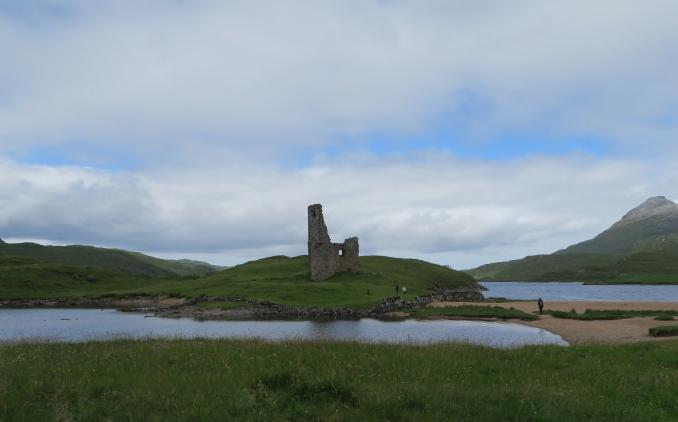
InterpNews
Legends and myths, such as the weeping Mermaid of Assynt, are often used to give an explanation for the physical features of an area. There are examples of this throughout the Celtic lands. One such is the Devil's Bit (Irish: Bearnán Éile) mountain in County Tipperary, Ireland which rises to a level of 1570 feet (478m) above sea level. There is a small gap in the mountain between one outcrop of rock and another small plateau. A gap, according to local legend, created by the devil taking a bite from the mountain. He broke his teeth taking this bite and spat the Rock of Cashel from his mouth to where it now stands about 20 miles (30 km) away. In the case of the Inchnadamph (Scottish Gaelic: Innis nan Damh) the area of Assynt surrounding Ardvreck Castle, the devil also played a part in the local geography. When angered by the broken promise of marriage he summoned meteoric rocks to fall. Scientific findings do indicate that north west Scotland was struck by an object from space around 1.2 billion years ago. Causing a massive impact and scattering material over a large part of the region. The Moine Thrust Belt, a geographic fault line around Assynt, is in legend also said to have been caused by the devil infuriated by the broken promise of marriage to the now weeping ghost of Ardvreck Castle beside Loch Assynt.







